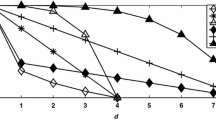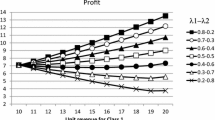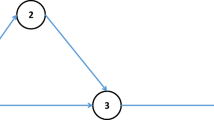Abstract
We develop a model for lead-time quotation in a Markovian Make-To-Order production or service system with strategic customers who exhibit risk aversion. Based on a CARA utility function, customers make individual decisions to join the system or balk after observing the state of the queue. The decisions of arriving customers result in a symmetric join/balk game. The provider announces a lead-time quotation for each state and a respective balking threshold. There is a fixed entrance fee and compensation rate for the part of a customer’ delay exceeding the quoted lead-time. We also consider the problem from the point of view of a social optimizer who maximizes the total system utility. We analyze the provider’s and social optimizer’s optimization problems and consider two classes of lead-time quotation policies, dynamic and single. We identify the optimal entrance thresholds in each case. Through computational experiments we quantify the effect of risk aversion on the profits and the flexibility the compensation policy offers. We show that the detrimental effects of risk aversion can be addressed more efficiently for the provider’s problem compared to the social optimizer’s one. Furthermore, the profit loss when setting a single lead-time quote is generally small compared to the optimal dynamic quotation policy.






Similar content being viewed by others
References
Afèche, P., Baron, O., & Kerner, Y. (2013). Pricing time-sensitive services based on realized performance. Manufacturing and Service Operations Management, 15(3), 492–506.
Ata, B., & Shneorson, S. (2006). Dynamic control of an M/M/1 service system with adjustable arrival and service rates. Management Science, 52(11), 1778–1791.
Benioudakis, M., Burnetas, A., & Ioannou, G. (2021). Lead-time quotations in unobservable make-to-order systems with strategic customers: Risk aversion, load control and profit maximization. European Journal of Operational Research, 289(1), 165–176.
Burnetas, A. N. (2013). Customer equilibrium and optimal strategies in Markovian queues in series. Annals of Operations Research, 208, 515–529.
Çelik, S., & Maglaras, C. (2008). Dynamic pricing and lead-time quotation for a multiclass make-to-order queue. Management Science, 54(6), 1132–1146.
Chen, J., Dong, M., Rong, Y., & Yang, L. (2018). Dynamic pricing for deteriorating products with menu cost. Omega, 75, 13–26.
Dixit, A., Skeath, S., & Reiley, D. (2015). Games of Stategy: Fourth International (Student). W. W. Norton & Company.
Duenyas, I. (1995). Single facility due date setting with multiple customer classes. Management Science, 41(4), 608–619.
Duenyas, I., & Hopp, W. J. (1995). Quoting customer lead times. Management Science, 41(1), 43–57.
Feng, J., Liu, L., & Liu, X. (2011). An optimal policy for joint dynamic price and lead-time quotation. Operations Research, 59(6), 1523–1527.
Feng, J., & Zhang, M. (2017). Dynamic quotation of leadtime and price for a Make-To-Order system with multiple customer classes and perfect information on customer preferences. European Journal of Operational Research, 258(1), 334–342.
Gallego, G., & van Ryzin, G. (1994). Optimal dynamic pricing of inventories with stochastic demand over finite horizons. Management Science, 40(8), 999–1020.
Hafızoğlu, A. B., Gel, E. S., & Keskinocak, P. (2016). Price and lead time quotation for contract and spot customers. Operations Research, 64(2), 406–415.
Hassin, R. (2016). Rational Queueing. Chapman and Hall/CRC.
Hassin, R., & Haviv, M. (2003). To queue or not to queue: Equilibrium behavior in queueing systems (Vol. 59). Springer Science & Business Media.
Hassin, R., & Snitkovsky, R. I. (2017). Self, Social and Monopoly Optimization in Observable Queues. In Proceedings of the 11th EAI International Conference on Performance Evaluation Methodologies and Tools - VALUETOOLS 2017, pages 214–220. ACM Press.
Haviv, M., & Randhawa, R. S. (2014). Pricing in queues without demand information. Manufacturing and Service Operations Management, 16(3), 401–411.
Liu, J., Zhai, X., & Chen, L. (2019). Optimal pricing strategy under trade-in program in the presence of strategic consumers. Omega, 84, 1–17.
Naor, P. (1969). The regulation of queue size by levying tolls. Econometrica: Journal of the Econometric Society, pages 15–24.
Öner-Közen, M., & Minner, S. (2018). Dynamic pricing, leadtime quotation and due date based priority dispatching. International Journal of Production Research, 56(15), 5118–5130.
Paschalidis, I., & Tsitsiklis, J. (2000). Congestion-dependent pricing of network services. IEEE/ACM Transactions on Networking, 8(2), 171–184.
Savaşaneril, S., Griffin, P. M., & Keskinocak, P. (2010). Dynamic lead-time quotation for an M/M/1 base-stock inventory queue. Operations Research, 58(2), 383–395.
Sun, W., & Li, S. (2012). Customer threshold strategies in observable queues with partial information of service time. In Communications in Computer and Information Science, volume 307 CCIS, pages 456–462.
Wang, J., & Zhang, Z. G. (2018). Strategic joining in an M/M/1 queue with risk-sensitive customers. Journal of the Operational Research Society, 69(8), 1197–1214.
Wang, X., Andradóttir, S., & Ayhan, H. (2019). Optimal pricing for tandem queues with finite buffers. Queueing Systems, 92, 323–396.
Zhao, X., Stecke, K. E., & Prasad, A. (2012). Lead time and price quotation mode selection: Uniform or differentiated? Production and Operations Management, 21(1), 177–193.
Acknowledgements
This research is co-financed by Greece and the European Union (European Social Fund- ESF) through the Operational Programme “Human Resources Development, Education and Lifelong Learning 2014-2020” in the context of the project “Mechanism Design in Supply Chains under Asymmetric Information and Delay Sensitive Strategic Customers” (MIS 5049554).
Author information
Authors and Affiliations
Corresponding author
Additional information
Publisher's Note
Springer Nature remains neutral with regard to jurisdictional claims in published maps and institutional affiliations.
Appendices
Appendix A : Proofs for the profit maximization problem
Proof of Lemma 1
(i) The expected customer utility is equal to :
where
and
The first integral is finite for any \(d\ge 0\). When \(\mu =rc\) it immediate that \(K_1(n,d)= \frac{(\mu d)^{n+1}}{(n+1)!}\), whereas for \(\mu \ne rc\) it can be shown by induction on n that
The second integral is infinite if \(\mu \le r(c-l)\). When \(\mu > r(c-l)\), it also follows by induction or standard properties that relate the Gamma and Poisson distributions that
(ii) From known properties of the Gamma distribution it follows \(X_n \le _{st} X_{n+1}\), where the inequality denotes stochastic ordering. In addition U(X) is decreasing in X since \(l \le c\). Thus, \(E\left( U(X_{n+1})\right) \le E\left( U(X_{n})\right) \) and \(B_{n+1}(d) \le B_n(d)\), for all d. The monotonicity of \(B_n(d)\) in terms of d for a fixed n is immediate. \(\square \)
Proof of Proposition 1
Let a fixed \(D=(d_0,d_1, \ldots )\). From Lemma 1 we know that \(B_n(d)\) is decreasing in d and n which implies that: \(\lim _{d \rightarrow \infty } B_n(d) \le B_n(d_n) \le B_n(0).\) Therefore, \(\underline{n} \le n_0(d) \le \overline{n}\), where
and
To derive the analytic expressions for the two bounds, we first consider \(\lim _{d \rightarrow \infty } B_n(d)\). From Lemma 1 we have the following cases: If \(\mu \le r(c-l)\), then \(\lim _{d \rightarrow \infty } B_n(d) = - \infty \), for all \(n\ge 0\). Similarly, when \(r(c-l) <\mu \le rc\), it is true that \(\lim _{d \rightarrow \infty } K_1(n,d) =\infty \) and since \(K_2(n,d)\ge 0\), it follows that \(\lim _{d \rightarrow \infty } B_n(d) = - \infty \), for all \(n\ge 0\) in this range as well. Therefore, if \(\mu \le rc\), then \(\underline{n}=0\). Finally, when \(\mu >rc\), we obtain from Lemma 1 that \( \lim _{d \rightarrow \infty } K_1(n,d) = \left( \frac{\mu }{\mu -rc} \right) ^{n+1} \) and \( \lim _{d \rightarrow \infty } K_2(n,d) = 0, \) thus
The above expression is decreasing in n and becomes negative for
Therefore, in this case
We next consider \(B_n(0)\). If \(\mu \le r(c-l)\), then \(B_n(0) = \infty \) for all \(n\ge 0\), thus \(\overline{n}=0\). If \(\mu \le r(c-l)\), then from Lemma 1, \(K_1(n,0) = 0\) and \(K_2(n,0) = \left( \frac{\mu }{\mu -r(c-l)} \right) ^{n+1}\), thus
from which it follows that
\(\square \)
Proof of Lemma 2
(i) For a fixed d, since the function \((X-d)^{+} \text { is increasing in} \)X\( \text {and}\) \(X_n \le _{st} X_{n+1},\) it follows that \(E(X_n-d)^{+} \le E(X_{n+1}-d)^{+}.\) Therefore \(L_n(d) \le L_{n+1}(d),\) for all d. The monotonicity of \(L_n(d)\) in terms of d for a fixed n is immediate.
(ii) We know that \(G_n(d)=p-lL_n(d)\). Therefore the proof follows from (i.).
(iii) Since, from Lemma 1, \(B_n(d)\) is decreasing in d, we have that \(B_n(d) \ge 0 \text { if and only if } d \le \tilde{d}^{P}_{n}.\) For any \(d \le \tilde{d}^{P}_{n+1}\) it follows that \(B_{n+1}(d) \ge 0\) and since \(B_n(d)\) is decreasing in n from Lemma 1, it follows \(B_n(d) \ge 0,\) thus \(d \le \tilde{d}^{P}_{n}.\) We thus see that \(\tilde{d}^{P}_{n+1} \le \tilde{d}^{P}_{n}.\)
(iv) For \(n < \underline{n}, \, \lim _{d \rightarrow \infty } B_n(d) > 0,\) which implies that \(\sup \lbrace d \ge 0: B_n(d) \ge 0\rbrace =\infty .\) Therefore, \(\tilde{d}^{P}_{n}=\infty .\) For \(n=\underline{n}, \, \lim _{d \rightarrow \infty } B_n(d) \ge 0.\)
(v) From (i), \(L_n(d)\) increasing in n and decreasing in d. We have also proved that \(\tilde{d}^{P}_{n+1} \le \tilde{d}^{P}_{n}.\) Therefore, \(L_n(\tilde{d}^{P}_{n}) \le L_{n+1}(\tilde{d}^{P}_{n}) \le L_{n+1}(\tilde{d}^{P}_{n+1}).\) Thus, \(L_n(\tilde{d}^{P}_{n})\) is increasing in n and \(G_n(\tilde{d}^{P}_{n})\) is decreasing in n. \(\square \)
Proof of Proposition 2
Let \(n_0\) be fixed and \(D_{n_0}=(d_0, d_1, d_2,\ldots ,d_{n_0-1}, d_{n_0})\) be a feasible solution of (5), with acceptance threshold \(n_0,\) i.e., \(B_n(d_n)\ge 0\) for \(n=0,1,\ldots ,n_0-1\) and \(B_{n_0}(d_{n_0})<0\) with \(d_n\ge 0\) for \(n=0, 1,\ldots , n_0\).
Since \(B_n(d_n)\) is decreasing from Lemma 1, it follows \(d_n \le \tilde{d}^{P}_{n}.\) Assume that \(d_k < \tilde{d}^{P}_{k}\) for some \(k \le n_0-1.\) We will show that \(D_{n_0}\) cannot be an optimal solution to (5). To see this, define another solution \(D^{'}_{n_0}=(d^{'}_0, d^{'}_1, d^{'}_2,\ldots , d^{'}_k,\ldots ,d^{'}_{n_0-1}, d^{'}_{n_0})\) with \(d^{'}_k = \tilde{d}^{P}_{k}\) and \(d^{'}_n=d_n\) for all \(n \ne k\).
Then \(B_n(d^{'}_n)\ge 0\) for \(n=0,1,...,n_0-1\) and \(B_{n_0}(d^{'}_{n_0})<0\) with \(d^{'}_n \ge 0\) for \(n=0, 1,.., n_0\). Thus, \(D^{'}_{n_0}\) is feasible. Also \(F_k(d^{'}_k)>F_k(d_k)\), therefore \(D_{n_0}\) is not optimal. \(\square \)
Proof of Theorem 1
Letting \(G_n=G_n(\tilde{d}^{P}_{n})\), \(H(n_0)\) can be written as:
For any \(\underline{n}\le n_0\le \overline{n}-1\) we have,
We next show that \(A(n_0)\) is decreasing in \(n_0\). For any \(\underline{n}\le n_0\le \overline{n}-2\),
since \(G_n\) decreasing in n from Lemma 2.
From (A1) and (A2) it follows that \(H(n_0+1)-H(n_0) \ge 0\) for \(n<\tilde{n}_P\) and \(H(n_0+1)-H(n_0) < 0\) for \(n \ge \tilde{n}_P\). Thus, \(\tilde{n}_P\) is an optimal value that maximizes \(G(n_0).\) \(\square \)
Appendix B : Proofs for the social benefit maximization problem
We first prove some intermediate properties on the distribution of the sojourn time in a finite capacity queue, that are necessary for the analysis in Sect. 6.
Let N, X denote the number of customers that an arriving customer finds upon arrival and the sojourn time of this customer respectively, in a \(M/M/1/n_0\) queue with service rate \(\mu \) in steady-state.
From the PASTA property the distribution of N is identical to the steady-state distribution of the queue length, i.e.,
The conditional distribution of X given \(N=n\) is \(Gamma(n+1,\mu )\), for \(n=0,\ldots , n_0-1\). Let \(f_{n,\mu }(x)\) and \(\overline{F}_{n,\mu }(x)\) be the corresponding pdf and tail probability respectively.
The marginal distribution of X corresponds to the sojourn time of a random customer. We obtain:
and
where \(Pois(n_0-1;\lambda x)\) the cdf of a Poisson distribution with rate \(\lambda x\).
The corresponding hazard rates of the conditional and the marginal distribution of X are:
1.1 B.1 Dynamic lead-time quotation
Lemma 5
For \(n \le n_0-1:\)
-
(i)
\((G_n+B_n)(\tilde{d}^{S}_{n})\) is decreasing in n.
-
(ii)
\(B_n(\tilde{d}^{P}_{n})\le B_n(\tilde{d}^{S}_{n})\).
Proof
(i) From Lemma 1, \((G_{n+1}+B_{n+1})(d) \le (G_n+B_n)(d)\) for all \(d \ge 0\). From the definition of \(\tilde{d}^{S}_{n}\), it implies that \((G_n+B_n)(d) \le (G_n+B_n)(\tilde{d}^{S}_{n})\) for all \(d \le \tilde{d}^{P}_{n}\).
Let \(d=\tilde{d}^{S}_{n+1}\). From the above inequalities we have: \((G_{n+1}+B_{n+1})(\tilde{d}^{S}_{n+1}) \le (G_n+B_n)(\tilde{d}^{S}_{n})\).
(ii) It follows from lemma 1 and the fact that \(\tilde{d}^{P}_{n} \ge \tilde{d}^{S}_{n}\). \(\square \)
Proof of Theorem 3
The proof is along similar lines as in Theorem 1, using that \((G_n+B_n)(\tilde{d}^{S}_{n})\) decreasing in n from Lemma 5. \(\square \)
Lemma 6
For \(X\sim Gamma(n,\mu )\) and \(Y\sim Gamma(n,v)\) with \(n\in \mathbb {N}\) and \(v<\mu \), it is true that:
-
(i)
The hazard rate \(h_{n,\mu }(d)\) is increasing in \(\mu \).
-
(ii)
\(\frac{\overline{F}_{n,\mu }(d)}{\overline{F}_{n,v}(d)}\) is decreasing in d.
Proof
(i.) Using the relationship between Gamma and Poisson distribution it follows that:
As a result,
Since \(k-n<0\), the last term is decreasing in \(\mu \), thus \(h_{n,\mu }(d)\) is increasing in \(\mu \).
(ii) The first derivative of \(\frac{\overline{F}_{n,\mu }(d)}{\overline{F}_{n,v}(d)}\) with respect to d is:
From (i.) it follows that \(h_{n,v}(d)<h_{n,\mu }(d)\), therefore the numerator of the above fraction is negative and the proof is complete. \(\square \)
Proof of Proposition 3
We fix \(n \in \left\{ 0,1, \ldots ,\overline{n}-1 \right\} \), and consider the problem of maximizing \(G_n(d_n)+B_n(d_n)\) in \(d_n\in [0,\tilde{d}^{P}_{n}]\). The first derivative of \(G_n(d_n)+B_n(d_n)\) is:
Since,
it follows that:
where \(a(d_n)\) is defined in (15). We will show that the derivative in (15) is either minimized at a unique point in \([0,\tilde{d}^{P}_{n}]\) or it is always positive. From Lemma 6 it follows that \(a(d_n)\) is decreasing in \(d_n\).
For \(d_n=0\), we have \(\overline{F}_{n,\mu }(0)=\overline{F}_{n,v}(0)=1\). Thus:
For \(d_n \rightarrow \infty \), by applying de L’ Hospital’s rule,
and also,
and
since the hazard rate \(h_{n,\mu }(d_n)\) of Gamma distribution is increasing in \(d_n\).
It follows that:
Since, \(a(0) \ge 0\) and \(\lim _{d_n \rightarrow \infty } a(d_n)<0\) and \(a(d_n)\) is decreasing in \(d_n\), there is a unique \(d^0<\infty \) such that \(a(d^0)=0\). Furthermore, \(a(d_n) \ge 0\) for all \(d_n \le d^0\) and \(a(d_n) < 0\) otherwise.
Returning to (B3), we consider the following cases regarding \(\tilde{d}^{S}_{n}\):
-
(i)
If \(\tilde{d}^{P}_{n}=\infty \), then from the previous discussion on \(a(d_n)\), it follows that \((G_n(d_n)+B_n(d_n))^{'} \ge 0\) for all \(d_n \le d^0\) and negative for \(d_n > d^0\). Therefore, the maximum of \(G_n(d_n)+B_n(d_n)\) in \(d_n\in [0,\infty ]\) is \(\tilde{d}^{S}_{n}=d^0.\)
-
(ii)
If \(\tilde{d}^{P}_{n}<\infty \), then the maximum point of \(G_n(d_n)+B_n(d_n)\) depends on the sign of \(a(\tilde{d}^{P}_{n})\). If \(a(\tilde{d}^{P}_{n})<0\) then \(\tilde{d}^{S}_{n}=d^0\in [0,\tilde{d}^{P}_{n}]\), otherwise \(\tilde{d}^{S}_{n}=\tilde{d}^{P}_{n}\).
\(\square \)
1.2 B.2 Single lead-time quotation
Lemma 7
Let X, Y be the sojourn times of a customer in two finite capacity \(M/M/1/n_0\) queues in steady state, with service rates \(\mu \) and v, respectively, and \(v<\mu \). Then:
-
(i)
The hazard rate \(h_{\mu }(d)\) is increasing in \(\mu \).
-
(ii)
\(\frac{\overline{F}_{\mu }(d)}{\overline{F}_{v}(d)}\) is decreasing in d.
Proof
(i) It is immediate that \(h_{\mu }(d)\) is increasing in \(\mu \) since:
(ii) The proof follows by differentiation of \(\frac{\overline{F}_{\mu }(d)}{\overline{F}_{v}(d)}\) as in the proof of Lemma 6 (ii). \(\square \)
Proof of Proposition 5
Using Lemma 3, we consider three cases regarding \(n_0\). (i) We first fix \(n_0 \in \big \lbrace \underline{n}+1, \ldots ,\overline{n}-1 \big \rbrace \), and consider the problem of maximizing \(S_c(d)\), for \(d\in (\tilde{d}^{P}_{n_0},\tilde{d}^{P}_{n_0-1}]\) where:
In the proof of Proposition 3, it was shown that:
Hence,
We have that
and
with \(\beta >0\).
Thus, the first derivative of \(S_c(d)\) with respect to d is equal to:
where \(a_c(d)\) is defined in (16). From Lemma 7 it follows that \(a_c(d)\) is decreasing in d.
Therefore, either \(a_c(d) \ge 0\) for all \(d\in (\tilde{d}^{P}_{n_0},\tilde{d}^{P}_{n_0-1}]\), in which case \({d}^{S_c}_{n}=\tilde{d}^{P}_{n_0-1}\), or \(a_c(d) \le 0\) for all \(d\in (\tilde{d}^{P}_{n_0},\tilde{d}^{P}_{n_0-1}]\), in which case there exist \(\epsilon \)-optimal lead-time quotes which approach the sup in (13) arbitrary close, since \(a_c(d)\) is continuous and decreasing and the lower bound cannot be attained by any d, or the maximizing value \({d}^{S_c}_{n_0}\in (\tilde{d}^{P}_{n_0},\tilde{d}^{P}_{n_0-1}]\) is the unique solution of \(a_c(d)=0\).
(ii) When \(n_0=\underline{n}\), we maximize \(S_c(d)\) for \(d\in (\tilde{d}^{P}_{n_0},\infty ]\).
For \(d \rightarrow \infty \), by applying de L’Hospital’s rule,
and also,
and
since the hazard rate \(h_{\mu }(d)\) is increasing in d.
It follows that:
Since \(\lim _{d \rightarrow \infty } a_c(d)<0\) and \(a_c(d)\) is decreasing in d, returning to (B4), the maximum point of \(G_n(d)+B_n(d)\) depends on the sign of \(a_c(\tilde{d}^{P}_{\underline{n}})\). If \(a_c(\tilde{d}^{P}_{\underline{n}}) >0\), then \({d}^{S_c}_{\underline{n}}\) is the unique solution of \(a_c(d)=0\). Otherwise, there exist \(\epsilon \)-optimal lead-time quotes which approach the sup in (13) arbitrary close.
(iii) When \(n_0=\overline{n}\), we maximize \(S_c(d)\) for \(d\in [0,\tilde{d}^{P}_{n_0-1}]\).
For \(d=0\), we have \(\overline{F}_{\mu }(0)=\overline{F}_{v}(0)=1\). Thus:
where \(a_c(0)\) can be either nonpositive or nonnegative.
In this case there is the closed interval \([0, \tilde{d}^{P}_{\overline{n}}]\). The only difference with the approach of case (i.) is that when \(a_c(d) \le 0\) for all \(d\in [0, \tilde{d}^{P}_{\overline{n}}]\), the optimal quote can be attained and it is \({d}^{S_c}_{\overline{n}}=0\). \(\square \)
Proof of Lemma 4
Let \(n_0\) be a balking threshold with \(a_c(\tilde{d}^{P}_{n_0})\le 0\). We know that \(Z_{n_0}(d)\) is decreasing in \(n_0\) and that \(a_c(d)\) is decreasing in d. Moreover the sign of \(Z^{'}_{n_0}(d)\) is determined by the sign of \(a_c(d)\). Therefore \(Z^{'}_{n_0}(d)\le 0\) and \(Z_{n_0}(\tilde{d}^{P}_{n_0})\ge Z_{n_0}(d)\) for any \(d\in (\tilde{d}^{P}_{n_0},\tilde{d}^{P}_{n_0-1}]\).
However, \(\tilde{d}^{P}_{n_0}\) is not a feasible value when the balking threshold is \(n_0\) but it is feasible when the balking threshold is \(n_0-1\). Additionally, \(Z_{n_0-1}(\tilde{d}^{P}_{n_0})\ge Z_{n_0}(\tilde{d}^{P}_{n_0})\).
From the above, it follows that \(Z_{n_0-1}(\tilde{d}^{P}_{n_0})\ge Z_{n_0}(d)\) for any \(d\in [\tilde{d}^{P}_{n_0},\tilde{d}^{P}_{n_0-1}]\) thus \(n_0\) cannot be an optimal balking threshold. \(\square \)
Rights and permissions
About this article
Cite this article
Benioudakis, M., Burnetas, A. & Ioannou, G. Single versus dynamic lead-time quotations in make-to-order systems with delay-averse customers. Ann Oper Res 318, 33–65 (2022). https://doi.org/10.1007/s10479-022-04802-4
Accepted:
Published:
Issue Date:
DOI: https://doi.org/10.1007/s10479-022-04802-4




